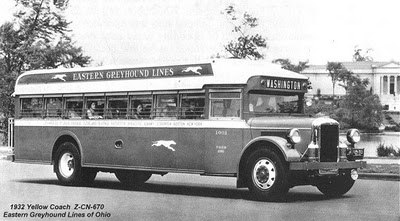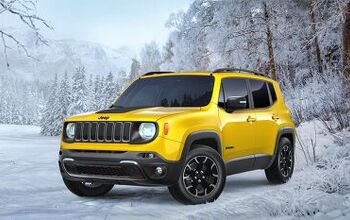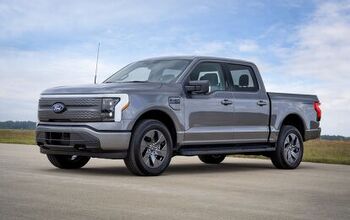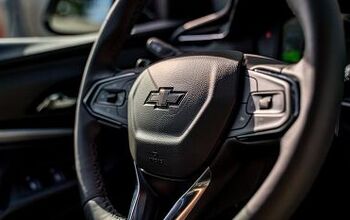Curbside Classic: 1947 GM PD-3751 "Silversides" Greyhound Bus – The First Modern Diesel Bus

This GM bus revolutionized the industry, and set the template for all over-the road buses to come: forward control, rear transverse diesel engine, the famous fluted aluminum “Silversides” cladding, semi-monocoque construction, high floor and underfloor luggage compartments. But its wildest feature was not replicated: a four-on-the-tree shifter and its mechanical linkage back to the non-synchronized gear box; something had to be left to improve. Let’s check it out and delve into the history and workings of its legendary Detroit Diesel 6-71 engine, which first made its appearance here.
First, let’s consider the setting into which it appeared: inter-city bus service once played a much more significant role than today, with numerous companies competing. And until the late thirties, buses were generally built like this; on heavy truck-type frames with the gasoline engine up front. Luggage rode on a roof-top rack.
That all changed with the 1936 Yellow Coach (owned by GM) Model 719 Super Coach, a groundbreaking design. It was conceived during that very creative mid-late thirties period, when traditional approaches to cars, buses trains and airplanes were all being tossed overboard. Yellow, encouraged and partly financed by Greyhound, decided to reinvent the bus. Dwight Austin, who had designed the remarkable but unsuccessful double-decker Pickwick Nitecoach, was hired by Yellow/GM to head up the effort.
Austin brought with him his patented angledrive system, which allowed the engine to sit transversely at the very rear of the bus for maximum space efficiency and accessibility. The new Model 719 also featured a semi-monococque (self-supporting) construction using aluminum to save weight, and large underfloor luggage compartments. The engine was a gasoline GMC 707 CID six, as GM’s new diesel engine wasn’t quite ready yet. But by 1938 it was, and in 1939 GM restyled the 719 with the then fashionable fluted polished aluminum “silverside” cladding.
The also groundbreaking Pioneer Zephyr of 1934 introduced the stainless steel fluted cladding, which came to typify streamlined trains and modern buses until just the last decade or two. Needless to say, it was also a mighty durable exterior finish. And the Zephyr also pioneered GM’s Elelectro-Motive Division two-stroke locomotive engine, which went on to revolutionize the train world.
Let’s swing open these beautiful louvered doors on the back, to expose that famous Detroit Diesel 6-71 engine.
GM’s two-stroke Detroit Diesel (“DD”) engine is one of America’s engineering marvels of the twentieth century. Designed under the direction of Charles Kettering at the GM Advanced Labs, the two-stroke principle was used in part because of the desire to have a compact and light engine for use in GM’s coaches, which dominated the industry, or would very soon. Many of you already know its operating principles, but for the uninitiated, they’re worth repeating again.
The DD is different from the typical loop-scavenged two-stroke engine, which has no valves and relies strictly on ports (openings) in the cylinder for the intake and exhaust, as well as crankcase pressure to help keep the gases flowing (typically, but not always). The DD two-stroke “Uniflow” has port openings in the cylinders for the intake air, but has two or four exhaust valves in each cylinder’s head. In order to fill the cylinder with fresh air since there’s no intake stroke, a blower is essential for its operation. Here’s a short video showing the DD two stroke cycle.
Conveniently exposed here to show one of its two overlapping lobed rotors, the 6-71 “Jimmy” Roots-type blowers soon found a new role as superchargers on dragsters and hot rods. In that application, they were overdriven to provide large amounts of boost; in the DD engine, they provide just enough of an increase above atmospheric pressure to evacuate and fill the cylinder with fresh air. Later versions also had turbochargers, which fed through the blower and increase power output. The blower couldn’t be eliminated though, because its boost is needed to start the engine and at idle.
The DD engine family was designed from scratch to be modular, to be built in many cylinder multiples. The “71” indicates the cubic inch displacement per cylinder; therefor this 6-71 has 426 CID. Two, three and four cylinder versions were offered from the beginning for powering everything from smaller trucks, gen-sets, pumps, tractors, marine use, and a host of other applications where its small size and durability put it to great advantage. Later, larger multiples were also built, including V8, V12, V16 and according to one source, even a V24. The smaller 53 family soon joined, and in more recent years, a 92 family largely replaced the 71 series. But the 71 family lasted into the 1990’s, and millions of these engines are still at work in all manner of vehicles, boats and equipment. The same basic two stroke diesel design was also scaled up and used in diesel locomotives, where GM enjoyed a near monopoly for decades.
What finally put it out of production was its slightly lower efficiency than the four stroke diesel. This was a small price worth paying in exchange for its compact dimensions and light weight. Higher fuel prices in recent years finally sealed its fate, but tightening emission standards would have likely been impossible to meet as well. BTW, these 6-71 powered coaches can get up to twelve miles per gallon.
Because of cheap fuel prices, diesel engines caught on slowly in the US. Initially, there were really just two common diesel engines for automotive (truck, etc) use in the US: the DD and the larger and heavier Cummins four stroke. And into the seventies and eighties, the two of them along with the Mack four stroke duked it out in the truck sector. But the DD was always instantly recognizable by its distinct exhaust howl, which sounded like it was revving twice as fast or more than the grumbling four strokes. But then all two strokes sound like they’re running twice as fast, obviously because they have twice as many exhaust strokes at any given engine speed. If you’ve ever heard a DD without a muffler, its scream will haunt you forever.
If you haven’t, here’s a video of the DD V12 in the hot rod Peterbilt above. As the owner points out, it may sound like it’s running at 6000 rpm, but its actual redline is 2500 rpm.
The next trick was to get the 190 hp or so that the early 6-71 made to the wheels. It’s torque being substantially more brutal than the gasoline engines it replaced, initially there were experiments with a diesel-electric drive, and a torque converter. Complications and efficiency losses with both led to a mechanical drive, an unsynchronized four speed, shifted by what has to be the biggest and gnarliest column shifter ever.
This picture is spoiled by the heavy tinting on the window and the light coming in the other side, but there it is, the black knob on the end of the shifter. Just try to imagine the mechanical linkage going back thirty-five feet to the transmission. Because of the challenges of the linkage, reverse gear was engaged by a solenoid, which can be clearly seen on top of the transmission along with the ends of the linkage (below). And check out that awesome art-deco driver’s seat.
You’re looking at the output end of the transmission and the angle drive that now sends the power forward to the rear axle. The working ends of shift linkage is visible, as well as a solenoid that engages reverse gear. I drove big transit buses, but never had the pleasure of trying to shift one of these stick versions. But I assure you, if you rode in these old buses, the shifts were very slow in coming, and if the driver hadn’t mastered the art of double clutching, down shifts never did happen, which could be deadly on a long steep downgrade in the mountains.
Since I’m snapping away, might as well get the output end of the angle drive and the short drive shaft to the rear axle, which had an offset differential. Also very visible are the big leaf springs, which was the one old-tech artifact. The next generation of GM buses, the almost equally revolutionary 1953 PD-4104, pioneered air suspension. The difference is huge; we had one old leaf spring transit bus, and it rode like a cart compared to the floating air-rides.
These 35′ coaches came in 37 or 41 passenger configuration, depending on how much leg room was desired. This obviously is the deluxe service version. Even a few 2 + 1 seating luxury versions were made. On-board lavatories were still a couple of years away, but air conditioning was available, which required its own small diesel engine to run the compressor.
This series of buses was made exclusively for Greyhound, but GM also made variations of the theme for all the other operators who clamored for them. If you look carefully at our featured bus, the outline of the greyhound logo is still visible. GM came to have an 80+% share of the bus market in the fifties, and was at risk of being broken up by the government, and GM made their engines and the later Allison automatic transmission available to the competition. That power train combination totally dominated the bus market until fairly recently.
Numerous problems with the Scenicruiser and other frustrations of dealing with a near-monopoly drove Greyhound to buy the Canadian bus builder MCI, and never looked back. Other builders eventually found their footing, and as GM’s market share plummeted in the seventies, they lost interest and pulled the plug in 1980.
This particular bus, like so many other old GM coaches, has been converted into a motorhome. It lost water heading back from Nevada, and damaged its engine, which is in the final stages of being replaced. With a freshly rebuilt 6-71, it should be good for another million miles or so.

More by Paul Niedermeyer
Latest Car Reviews
Read moreLatest Product Reviews
Read moreRecent Comments
- MaintenanceCosts The Supercharger network is something with much more growth potential than their actual car building operations, which has been marvelously run to this point and has a years-long head start on all its competitors, and Elon lays the whole team off?I don't know if it's distraction or the drugs, but he is not making good decisions and should not be CEO anymore.
- Dirk Wiggler I drive down the Palisades and near the George Washington Bridge I see FIAT housing complex (apartments, same font as the auto company). Seems like they tout energy/electric efficiency. I always wonder, 'what's that...is it really the same FIAT?'
- The Oracle Massive job cuts at their state-funded facility in Buffalo. Tesla is quick to throw resources at programs to get them launched, and quick to contract when the models are in serial production:
- Cprescott Golf carts were so 1900 and so 2020. Everyone who wants one has one and is trading them in for hybrids.
- Cprescott If it were Honduh or Toyoduh's I would set it on fire.



















































Comments
Join the conversation
Hey guess I'll bump an old post. Hi All! I stumbled across this site while searching for info on an absolutely awesome bus I came across a couple of weeks ago. Great article and site btw. All I know of the bus is that is a GM. I didn't have my camera with me both times I went to look at it. It is parked in front of an older house in an old neighborhood, which I noticed last time through had a number of classic rides sprinkled about it. I wanted to find out more info about the "beast" before bothering the owner as I would like to see if it might be for sale. I'll update when I have some pictures and more info. For now I just wanted to say thanks and HI! Ursus.
Great memories! Worked part time and drove ski charters for an operator that had two old silversides. He always cautioned me to take it easy between second and third and never slop the gate or risk hanging up the linkage. I never did and I got to be expert and powershifting from fourth down to third climbing hills. The four on the tree was actually a nice transmission. The steering was the other part "Armstrong steering"! Silverside was a great coach, though. So comfortable and quiet on the inside compared to the PD4104 traveler.